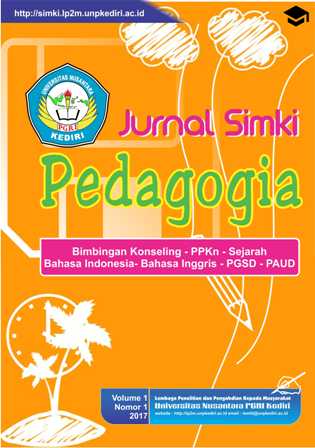THE IMPLEMENTATION OF TEACHING SPEAKING FOR CHILDREN OF ENGLISH MASSIVE (EMAS) PROGRAM AT SPOT TAMBAH PINTER, NGRONGGO-KEDIRI
Author (Penulis)
KANITA MELARILLIS CITAUniversitas Nusantara PGRI Kediri
Author Identity (NPM)
14.1.01.08.0106Abstract
EMAS (English Massive) program was designed by Kediri City Government that aimed to equip the citizens within English ability especially in speaking skill in order to face AEC (ASEAN Economic Community). This program is tuition free and the participation is divided by three groups; Adult, Teenager, and Children. Teaching speaking to the children is different with the adolescent, so that the tutor should arrange the activity that appropriate with the children’s needs as well as their characteristics. Furthermore, the tutor also has the responsibility to create the most enjoyable atmosphere so the expectation of fun learning can be materialized. The writer conducted a case study of qualitative research approach. The aim is to explain the way of the tutor conduct the teaching learning for the speaking skill. While, to collect the data she conducted observation, interview and documentation. The finding of this research shows that the tutor made teaching scenario before conducting the teaching learning process. She also did physical activity such as sing a song and game. The tutor never shouted to the member when they were crowded and she made be quiet sign and made a yel-yel. At the end of teaching learning process, the tutor assessed and evaluated the member orally. From the finding, it can be concluded that the tutor who conducts teaching speaking to the children applies activity such as game and sing a song that supports the enjoyable atmosphere. In order to make the teaching learning more effective, the writer suggests that the tutor uses hand book that contains of the material they learn.
Keyword: EMAS Program, Teaching Speaking, Children
Keyword
aReference
Ary, Donald. 2010. Introduction to Research in Education Eighth Edition. USA: Wadsworth
Branson, Jane., Goodwyn, Andrew. 2005. Teaching English:A Handbook for Primary and Secondary SchoolTeachers. New York: Routledg
Brown, H. Douglas. 2000. Teaching by Principles an Interactive Approach to Language Pendagogy (2nd Edition). New York: Longman
Creswell, John W. 2012. Educational Research: Planning, Conducting, and Evaluating Quantitative and Qualitative Research. Boston: Pearson
Evi, Ashartini,. Susilawati, Endang., Sala, Urai. 2017.Teaching Vocabulary by Using Hangman Game toEighth Grade Students SMP DDI SSA Pontianak. English Education Study Program FKIP Untan Pontianak. 1(1):3
Huberman, A., Miles, Matthew. 1994. An Expanded Source Book Qualitative Data Analysis (2nd Edition). USA: Sage Publications
Linse, Caroline T., Nunan, David. 2005. Practical English Language Teaching: Young Learners. New York: The McGraw-Hill Companies
Manan, R.M. 2016. The Use of Hangman Game in Motivating Students in
Learning English. 4(2):139,141
Mardiani, Desika. 2012. Partisipasi Masyarakat dalam Kursus Bahasa Inggris Sebagai Upaya Mewujudkan Community-Based Education di Kampung Inggris Kecamatan Pare Kabupaten Kediri. State University of Surabaya. 1(1):1
Ministry of Education and Cultural of Indonesian Republic. 2003. No 20. Undang-Undang Republik Indonesia. Sistem Pendidikan Nasional
Novosadova, Monika. 2003. NFE BOOK: The Impact of Non Formal Education on Young People and Society. Belgium: AEGEE-Europe
Smith, Gregory., Sobel, David. 2010. Place- and Community-basedEducation in Schools. New York: Routledge
